The $6 Billion Question: Reality-Checking Baker’s Claimed Cost of Extra Climate Protection
In the flurry of activity at the end of 2020, two landmark (though long-expected) climate visions were put forward by different branches of the Massachusetts government. One, offered by the Executive Office of Energy and Environmental Affairs and backed up by its comprehensive draft Clean Energy and Climate Plan for 2030, called for the state to reduce its greenhouse gas (GHG) emissions in the year 2030 by 45% compared to 1990 emissions. The other, a bill passed with overwhelming legislative support entitled “An Act creating a next-generation roadmap for Massachusetts climate policy”, called for a 50% reduction by 2030, instead of 45%, among many other positive provisions. On January 14th, Governor Baker vetoed the bill. But with the arrival of the 2021 session, the legislature passed the same bill again on January 28th, which the Governor must sign or veto by February 7th (although the large majorities in both bodies’ initial vote mean the legislature could override any veto).
Acadia Center has already debunked other claims in the Governor’s first veto. In his explanatory letter, the Governor claimed unlocking that extra 5% of GHG savings (the difference between 45% and 50%) would come with an extravagant cost: $6 billion more, to be exact. That figure, and how the Governor’s Office arrived at it, has touched off a number of conversations within the legislature and environmental advocacy community, because there has been little information revealed about where it came from.
Despite this, one can still infer valuable information from the Administration’s estimates for 2030. To explore this further, it is important to distinguish between an annual and a cumulative value. If, by 2030, Massachusetts reduced its annual emissions by 50%, the state would be emitting about 4.7 million metric tons[1] of GHGs less, annually, than if it only achieved a 45% reduction. Assuming those two reduction pathways gradually diverge between 2020 and 2030, that means – with a little help from high-school geometry – that the cumulative difference would be around 20-25 million metric tons. This is the triangular “wedge” of GHGs shown in the chart below, and this wedge, according to the Administration, is what costs $6 billion extra.
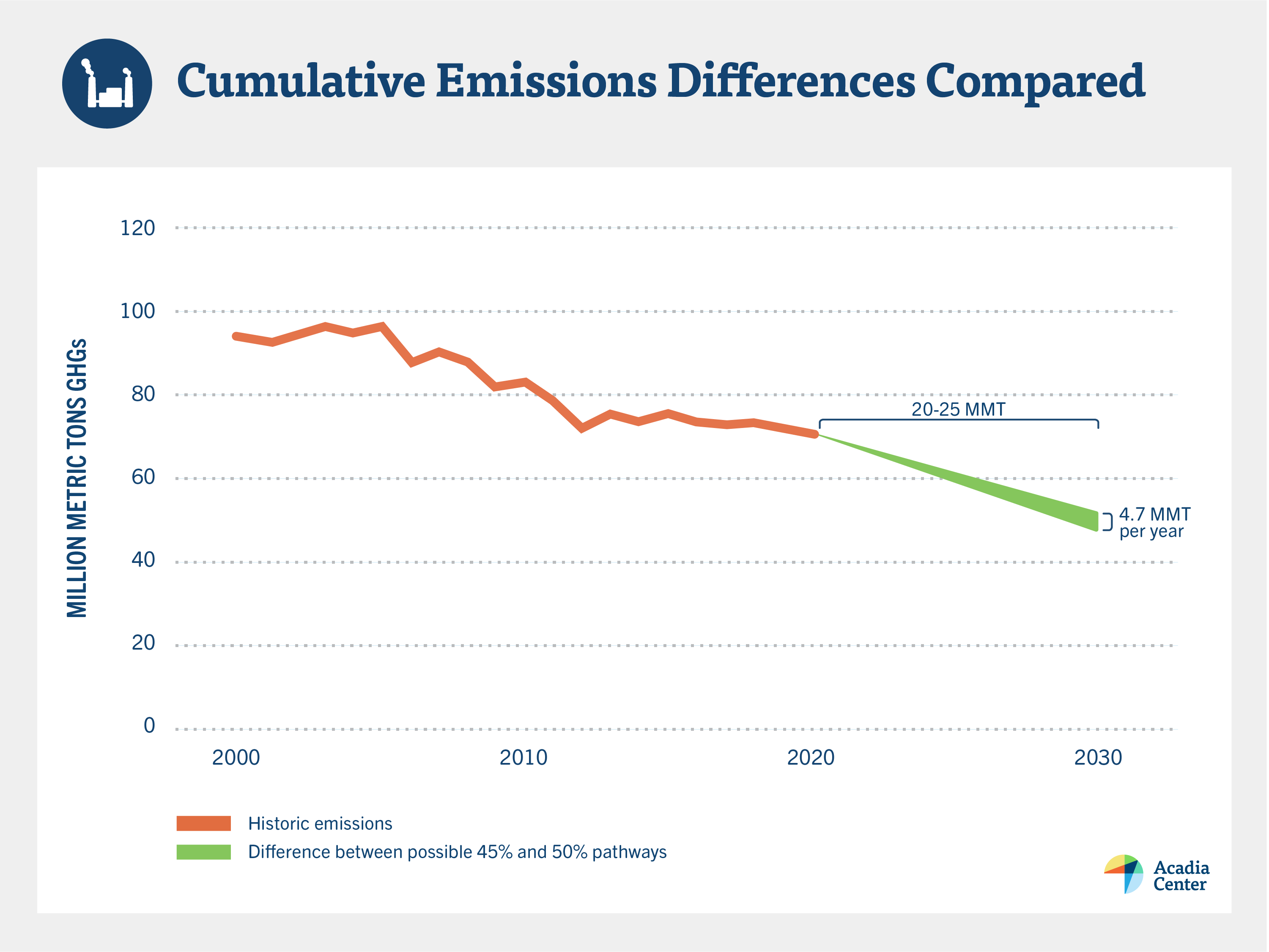
Now consider two important charts, included below, taken from December’s Massachusetts 2050 Decarbonization Roadmap reports, which contain the technical analyses that underpin policies set forth in the Clean Energy and Climate Plan, or CECP. These two charts show cost and emission differences between the study’s “All Options” scenario, which by 2030 attains GHG reductions of 47% compared to 1990[2], and its “Reference” scenario, which attains reductions closer to 15%. Reading the charts, it appears the “All Options” scenario cumulatively avoids about 150 million metric tons of GHGs and costs roughly $4.75 billion more than “Reference” by the year 2030.
To phrase it another way, the Roadmap analysis suggests that the average cost to get from 15% to 47% (and avoid about 150 million metric tons of emissions by 2030) is about $32 per metric ton avoided. This figure is also in line with a recent Applied Economics Clinic paper that explicitly calculated carbon “abatement costs” for Massachusetts. But the Baker Administration, in their justification for a more restrained 2030 target, says that to go from 45% to 50% could cost almost ten times that amount: $240-$300 per metric ton[3]. It is no surprise that bigger emissions cuts cost more, and costs per ton escalate as the least expensive options are exhausted first. Here, increased costs could mean that some polluting cars and fossil-fueled heating equipment would be replaced before they completely wear out. But the vast difference between these numbers, both of which come out of the same Administration within a few weeks of one another, suggest that different math is being used to tackle the same question.
Figure 5 from the Economic and Health Impacts Report, showing annual costs for modeled scenarios versus the “Reference” scenario. The area below the brown “All Options” line shows the cumulative cost difference for that scenario to be approximately $4.75 billion between 2020 and 2030.
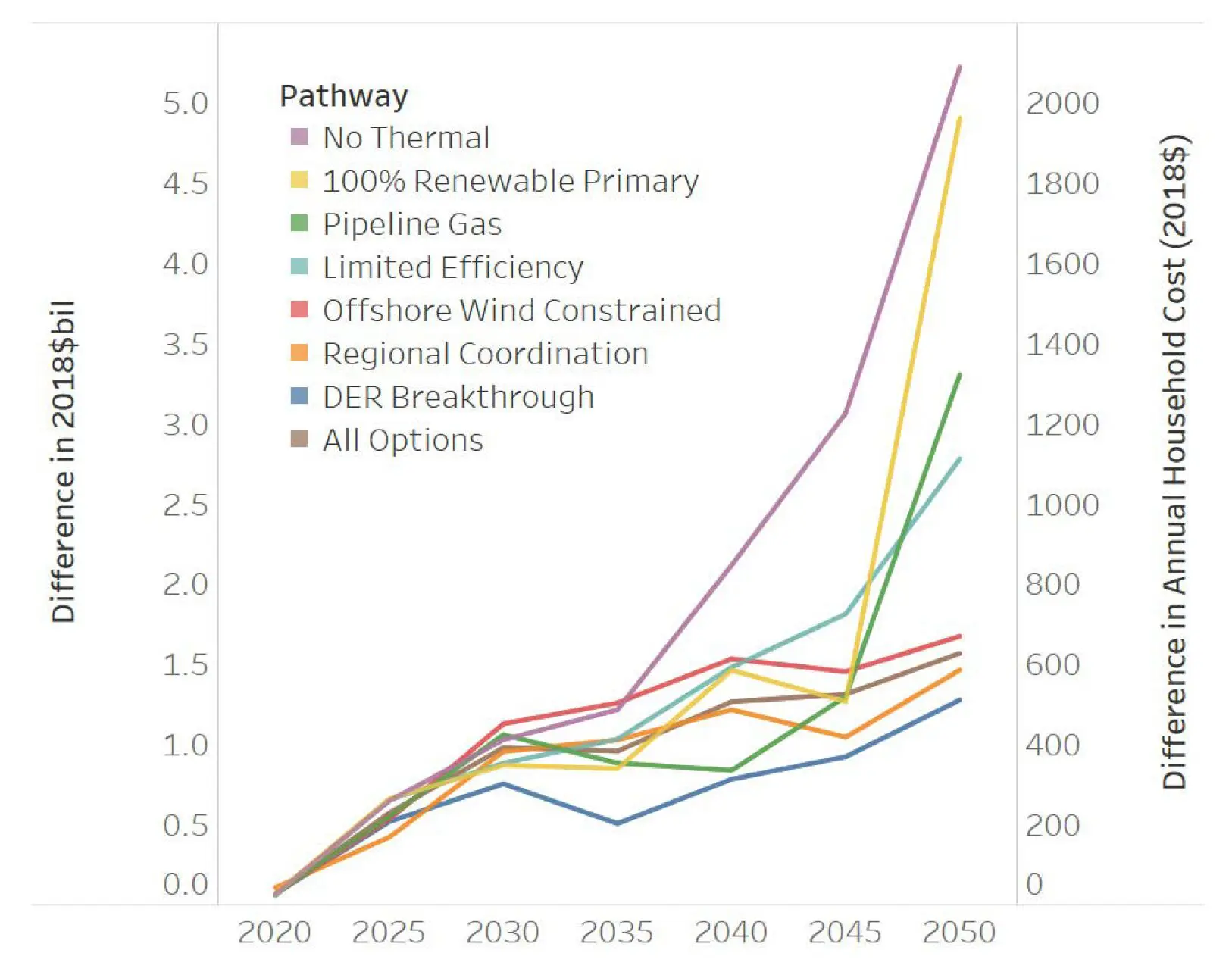
Figure 46 in the Energy Pathways to Deep Decarbonization Report, showing cumulative emissions for the “All Options” and “Reference” scenarios. By 2030, the accumulated difference between the two would be 150 million metric tons.
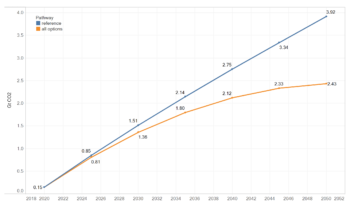
A recent Boston Globe article by David Abel sheds some light on the Administration’s math, focusing on what it would take to stretch beyond the 45% target. For example, the article cites members of the Administration who say the Commonwealth would need 450,000 additional electric vehicles (EVs), which alone would cost $2.4 billion. That would mean over $5 thousand per car in extra costs. But what about the lower fuel and maintenance costs that EV owners enjoy? Even Consumer Reports acknowledges that the total cost of ownership for EVs is less than a car running on gasoline. And what about the other benefits to the public from breathing cleaner air with almost half a million fewer fossil-powered cars on the road? It appears that the Baker Administration’s math may not be accounting for all the benefits in the same way that the Decarbonization Roadmap does.
To be clear, achieving either of these 2030 aspirations, whether 45% or 50%, would be a significant milestone in Massachusetts’ fight against climate change. All other things being equal, fewer total emissions are better than more, since what really matters is the accumulation of GHGs in the atmosphere. Acadia Center is a firm believer in evidence and data-backed policymaking, and the CECP is a tremendous accomplishment, founded on solid analysis. If the Baker Administration is going to use cost to explain why it opted for a less aggressive emissions target, Acadia Center simply feels that the same level of rigor should be brought to that decision as is seen in the Decarbonization Roadmap. Luckily, the bill containing the 50% goal is already back on the Governor’s desk. Acadia Center urges him to reevaluate his position – or at least base it on cost figures that are supported by evidence his own Administration has gathered.
Image credit: https://www.flickr.com/photos/massgovernor/50881414713/
[1] This can be calculated from the annual GHG emissions inventory.
[2] This value lies in between 25% in 2020 and 90% in 2050, and Acadia Center understands that the “All Options” scenario follows this straight line emissions trajectory.
[3] This is Acadia Center’s estimate of the range of marginal abatement costs implied by the Baker Administration’s letter. It relies on approximate values estimated from charts and simple reasoning, since the complete information needed to perform the calculation has not been provided.
A shocker in the plan to finally update residential solar rates: no complaints
Connecticut is on the verge of changing one of the key financial underpinnings for residential solar electric systems, and, for the first time in more than a decade, it appears no one is complaining.
The change is in how solar owners are compensated for the excess power their systems produce at certain times. The rates for how that is calculated and structured will be altered, but in exchange, systems will be allowed more flexibility to accommodate future larger electricity needs.
Solar systems obviously don’t make any power at night – but during the day, they often make a lot more power than the house they’re sitting on needs. For the most part, that power is sold back to the grid.
How a homeowner is paid for the power it sends to the grid has been a flashpoint for years. The battle has been between the utilities and just about everyone else.
On Jan. 20, the Public Utilities Regulatory Authority released a draft plan for a new way to handle that compensation. It is open for comment until Feb. 2. Unlike previous ideas floated over the last several years, it has elicited initial reactions that are a head-snapping 180 degrees from what all parties have come to expect.
….
Amy McLean, Connecticut director of the advocacy group Acadia Center said she was “pleasantly surprised. It will be a better part of the solution going forward.”
Read the full article in The CT Mirror here
Vehicle Emissions Reduction Program Set to Start in the Northeast
The transportation sector accounts for nearly 40% of greenhouse gas emissions in the Northeast and Mid-Atlantic, so any effort to reduce emissions must include a focus on this sector. “Transportation pollution is becoming a growing crisis both because of its contribution to climate change but also because of the damaging health impacts it has on communities,” said Jordan Stutt, Carbon Programs Director at Acadia Center.
Read the full article in the AAA Northeast Magazine here
Lamont Remarks on Killingly Plant Raise Eyebrows of Green Energy Proponents
Remarks Gov. Ned Lamont made this week opposing a controversial plan to build a new 650 MW gas-fired plant in Killingly raised eyebrows, and questions about how to reconcile his words with recent approvals by state regulators of new gas infrastructure.
The Killingly plant, which was first proposed by Florida-based NTE Energy in 2016, has become a key rallying point in the ongoing effort to promote new sources of renewable energy for Connecticut and to scale back – and eventually eliminate – power plants that burn fossil fuels.
“I don’t want to build Killingly,” Lamont told environmental advocates assembled for the League of Conservation Voters annual Environmental Summit on Tuesday. “I’m not interested in building Killingly, and I’m not sure that the market will say that we need Killingly.”
….
“It’s a good sign that the administration is clearly sending a signal that further investment in gas infrastructure in Connecticut is not welcome, and it is antithetical to the interests of Connecticut residents and inconsistent with the long-term climate plan of the state,” said Deborah Donovan, senior policy director at Acadia Center, a nonprofit dedicated to “equitable clean energy solutions.”
Read the full article in The Connecticut Examiner here
Conservative group criticizes transportation climate plan
PROVIDENCE — Rhode Island’s leading conservative advocacy group argues in a report released Tuesday that the costs of a regional program to cut transportation emissions would far outweigh the benefits.
The report released by the Rhode Island Center for Freedom & Prosperity comes a month after Gov. Gina Raimondo signed Rhode Island onto the Transportation and Climate Initiative, joining Massachusetts, Connecticut and the District of Columbia as founding members of a cap-and-invest program aimed at helping to reduce the greenhouse gas emissions that drive climate change.
The initiative has won broad support from environmental and public health groups who say that cutting pollution from the transportation sector, which is responsible for about 40% of all carbon emissions regionally, will have far-reaching impacts.
….
Hank Webster, Rhode Island director of the Acadia Center, which signed the letter of support for the initiative released on Tuesday, said the center’s report aims to deceive policymakers by focusing on the 2019 legislation.
“Ignoring climate change and the rapid shift away from fossil fuels won’t help Rhode Islanders, and neither will false information,” he said.
Read the full article in The Providence Journal here
Next Generation Energy Efficiency
The buildings in which we live and work are a main driver of energy use and play a key role in determining public health outcomes. Emissions from appliances and heating and cooling systems negatively impact indoor air quality, exposing residents, especially in poorly ventilated buildings, to toxic pollutants. In New England and New York, building heating, cooling, lighting, and operations are responsible for over a third of the overall emissions that contribute to climate change.
Energy efficiency, including services ranging from home insulation improvements to replacing appliances with more efficient alternatives, can improve comfort, reduce exposure to pollutants, and save consumers money. Energy efficiency is also the most cost-effective way to reduce greenhouse gas emissions and has played a major role in helping the Northeast lower carbon pollution.
The Northeast is a national leader in energy efficiency. Efficiency programs in the Northeast lead the nation in important criteria: the highest per capita investments in energy efficiency and the most ambitious energy savings goals. The regional grid operator in the six-state New England region relies on energy efficiency resources for over 14% of the power needs of the region – the highest in the country. Millions of homes and businesses have received efficiency services, which have reduced energy bills, avoided billions of dollars in higher cost energy resources, and improved public health.
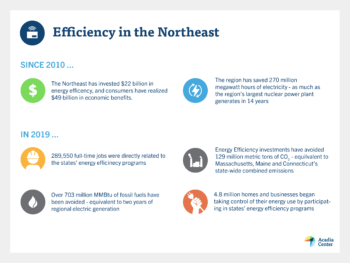
Acadia Center is proud of the role it has played in advancing energy efficiency in the region and promoting the creation of stakeholder boards to guide efficiency programs, budgets and goals, but far more must be done to improve the efficiency of our homes and businesses and to ensure that all overburdened and underserved communities reap the full benefits of efficiency offerings. Programs have not delivered services adequately across all income levels and communities. Many consumers face unequal access to benefits under existing efficiency programs, and underserved communities that face the worst impacts of climate change and poor housing quality have not been able to take full advantage of efficiency programs. Clean electric heating and whole house electrification must be priorities to support the acceleration of clean energy resources and the transition away from fossil fuels. There must be better alignment between state climate goals by reforming key energy efficiency policies, regulations, and stakeholder systems, and the region must continue to value energy efficiency as a core energy resource.
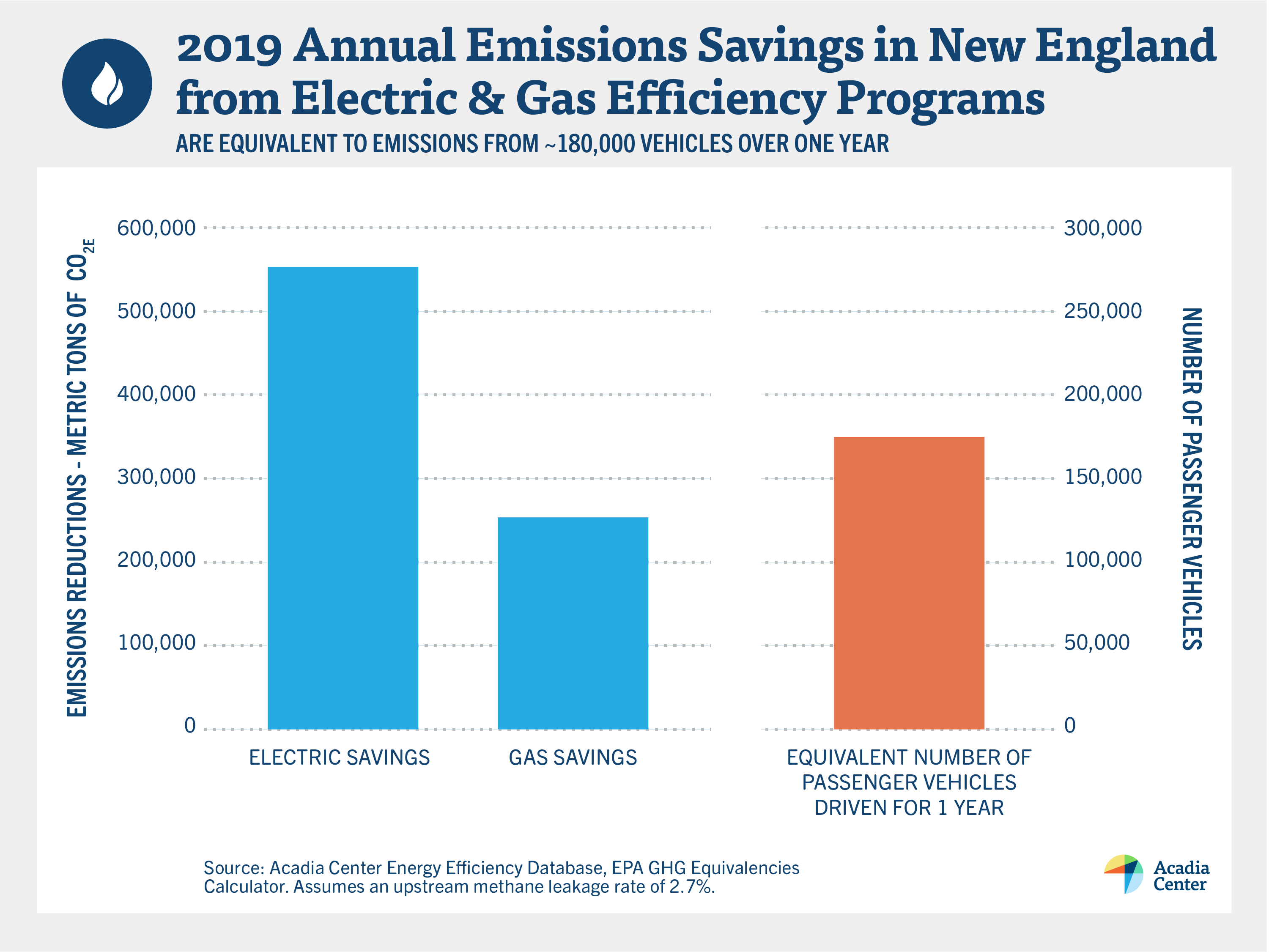
Acadia Center’s Next Generation Energy Efficiency initiative seeks to tackle these challenges through a new approach – one that focuses on energy savings as a core consumer and energy system resource, but is also centered around meeting climate, environmental justice, and electrification goals. It is an approach that recognizes the interrelatedness of these efforts, which can work in concert to bring Northeast communities the future of energy efficiency.
The four challenges the Next Generation Energy Efficiency will prioritize are 1) sub-standard housing quality, 2) climate mitigation, 3) clean heating and whole-house electrification, and 4) sustaining investments in efficiency as the leading energy resource option for utilities and the power grid.
Prioritize Housing Quality Improvements
Energy efficiency must be at the center of addressing the region’s old housing stock. Energy efficiency can improve thermal comfort, reduce exposure to toxins, and lower energy costs. To better serve vulnerable populations and environmental justice communities, existing benefit-cost methodologies, which determine how efficiency programs are implemented, must incorporate climate, equity, and health benefits from building retrofits. Acadia Center will work with environmental and consumer advocates, environmental justice leaders, business interests, and efficiency vendors to develop policy recommendations that identify reforms needed to fully account for all the health, safety, and equity benefits that energy efficiency improvements deliver.
Ensure Alignment with Climate Mitigation
Every kilowatt-hour of electricity that does not need to be produced because of energy efficiency means less dirty fossil fuel use. But energy efficiency programs can achieve even deeper emissions savings if they are refocused with a greater emphasis on climate mitigation. Acadia Center will press to:
- Update efficiency statutes and regulations, including the way programs are screened through benefit-cost tests, to emphasize reductions in greenhouse gas emissions in addition to energy savings.
- Make certain that public utilities commissions consider climate and health impacts when evaluating efficiency programs; and
- Ensure that laws, regulations, and planning processes support efforts to transition from fossil fuels to clean electrification.
Embrace Clean Heating and Whole-House Electrification
If deployed together, energy efficiency and electrification can deliver greater emissions reductions while improving indoor air quality. To better align efficiency programs and electrification, Acadia Center will push for incentives for clean heating and weatherization, as well as for changes in how efficiency programs are administered to ensure co-delivery of building upgrades that are currently delivered in silos. Acadia Center will publish state-specific reports on the value of electrification and flexible demand and will push states to include electrification retrofit pathways in their efficiency plans.
Sustain Investments in Efficiency as the Leading Energy Resource
Northeast states must expand efficiency investment levels and energy savings goals to ensure deeper savings and benefits for all. As one of the fundamental components of meeting state emissions targets, efficiency efforts must be sustained in states that are already leading and improved in states that are falling behind. Acadia Center will work to ensure that decision-makers in the Northeast recognize the value and necessity of efficiency to spur large savings in public health and economic benefits. Through membership on efficiency boards and through PUC intervention related to efficiency plans, Acadia Center will continue to advocate for increased budgets and the maximum possible savings goals, provide expert commentary on state energy issues, and offer data and recommendations to counter bad decisions.
For more information:
Oliver Tully, Policy Strategist, otully@acadiacenter.org, (860) 246-7121, ext. 202
As lawmakers plan to send a new climate bill to the governor, state officials and lawmakers wrangle over the true costs
When Governor Charlie Baker this month vetoed a landmark bill to address climate change, he told lawmakers that his controversial decision was motivated in part by the legislation’s requirement that the state reduce emissions by 50 percent below 1990 levels by the end of the decade.
That target was only slightly more ambitious than a plan his administration released only a few days before, which sought to cut emissions by 45 percent over the same period. But that difference, he said, would cost the state a whopping $6 billion more.
….
Deborah Donovan, a senior policy advocate at the Acadia Center in Boston, said less pollution would result in fewer sick days, and retrofitting buildings would likely produce more jobs.
“It’s important to look at the full range of costs and benefits when setting our goals and creating a suite of policies that will get us there,” she said.
Read more from the Boston Globe here
Massachusetts Climate Policy Roundup
In early January, the Massachusetts legislature overwhelmingly passed a landmark update to the state’s 2008 Global Warming Solutions Act through Bill S.2995, “An Act Creating a Next-Generation Roadmap for Massachusetts Climate Policy.” Many of the provisions have been championed by Acadia Center and we are encouraged by its breadth and specificity. Bill S.2995 represents meaningful progress in addressing the Commonwealth’s contributions to climate change, codifying the Governor’s commitment to a net-zero future, delivering effective environmental justice strategies, and moving critical sector-specific initiatives forward. It will help increase overall demand for clean energy and support the growing clean energy economy.
Governor Baker employed the pocket veto on January 14th. The timing of the bill passage and the veto as one legislative session concluded and another began made it impossible for the legislature to override the Governor’s veto. Demonstrating resolve and commitment to the overwhelming support for the landmark bill, House and Senate leadership refiled an identical bill, S.9, which is expected to come to a vote in the next week or so, and again pass quickly with veto-proof margins.
Significant provisions of the legislation include:
- “Comprehensive, clear and specific” plans for achieving statewide emissions limits now set every five years (rather than ten) leading to: 50% reductions from 1990 levels in 2030, 75% in 2040, and net-zero emissions by 2050.
- New tools and protections for environmental justice populations, and plans to improve or mitigate economic, environmental, and public health impacts for these populations.
- Mandates for emissions sub-limits for six priority sectors of the economy: transportation; electric power; residential heating and cooling; natural gas distribution and services; and natural and working lands, an idea catalyzed by Acadia Center.
- A requirement also endorsed by Acadia Center: The Department of Public Utilities (DPU) must consider equity and reductions in greenhouse gas emissions as equal priorities to reliability, safety, and affordability. This is essential to empowering the DPU to act in alignment with the state’s climate goals.
- Boosting the Renewable Energy Portfolio Standard by 3% each year, ensuring that at least 40% of the state’s electric power will be renewable by 2030.
- An increase to the standard for greenhouse gas emissions for municipal lighting plants for the first time, requiring 50% non-emitting electricity by 2030 and “net zero” emissions by 2050.
- An expansion of previous targets that increases the state’s total offshore wind authorization to 5.6 gigawatts (GW).
- A local option mandates – “net zero stretch energy code” – which would allow towns to ban the use of fossil fuels in new buildings.
- The adoption of appliance efficiency standards in line with California; this may enable Massachusetts to take back the top spot in the rankings of American Council for an Energy Efficient Economy (ACEEE).
- A requirement that energy efficiency plans achieve a greenhouse gas (GHG) emissions reduction goal and include the value of GHG reductions in cost-effectiveness calculations – two reforms at the heart of Acadia Center’s Next Generation Energy Efficiency strategy.
As one of the co-chairs of the ACES coalition, Acadia Center worked to pull together over 20 clean energy businesses and advocacy organizations to sign on to a letter urging Governor Baker to sign the bill and empower Massachusetts to address the climate crisis.
The climate roadmap envisioned in the newly filed S.9 will put into law the commitments made by the Baker Administration’s Clean Energy and Climate Plan for 2030 and beyond, setting our Massachusetts on a path to reach net-zero emissions and avoid the worst impacts of climate change. As well, Bill S.9 includes vitally important provisions ensuring that front line communities and low-wage workers will benefit from the Commonwealth’s transition to a low-carbon economy. Acadia Center strongly support S.9 and greatly appreciates the resolve of House Speaker Mariano, Senate President, Representative Golden and Senator Mike Barrett for quickly reintroducing the legislation. Acadia Center looks forward to swift passage of this important climate legislation, and urges Governor Baker to enact without changes it so that all the state’s residents can benefit from a healthier, safer future.
Acadia Center Launches Redesigned Website
BOSTON – On January 19th, Acadia Center launched its redesigned website at acadiacenter.org
This new site amplifies Acadia Center’s work by using more visual storytelling, and elevates its human impact. Climate change and energy work can be abstract and technical, and the new site aims to make the work tangible and relevant to a much broader audience. This new approach is reflected in refreshed aesthetics, images and improved navigation, so users can easily find news and reports connected to any issue. A section called Latest highlights relevant news and blogs. The site creates an engaging experience by gently guiding users through the work in bite-size pieces, while using increased page-to-page relationships to encourage deep dives.
The new website groups Acadia Center’s work into four Areas of Focus, which encompass the many programs that the organization works on, from energy efficiency to phasing out natural gas. It also includes dedicated pages for each Northeast state that Acadia Center works in, easily accessible in the Our Work section.
In keeping with an increased focus on public outreach, Acadia Center will begin rolling out educational materials aimed at a wide set of audiences, with the goal of reaching beyond an “in the know” audience of policy professionals and giving interested newcomers a grounding in key energy terms and concepts that they can use in advocacy. At the same time, the new website makes Acadia Center’s high-quality reports and technical analyses more easily searchable and accessible for reference, especially with a new Related Resources feature.
Lastly, more information is available in the Get Involved section of the website, where interested visitors can learn more and sign up for updates.
For any questions or comments, please contact Emma Rapperport at erapperport@acadiacenter.org.
Fact check: net-zero stretch code is the right move for Massachusetts
Yesterday, Massachusetts Governor Charlie Baker vetoed S. 2995, “An act creating a next-generation roadmap for Massachusetts climate policy.” As the Boston Globe reported earlier this week, and as the Governor’s letter to the legislature confirms, opposition from the real estate industry played a significant role in the decision.
The section of the bill that has drawn the ire of real estate groups has to do with the energy efficiency parts of the building code. Currently, Massachusetts has both a standard (or “base”) building energy code and a “stretch” code. The stretch code allows cities and towns to opt in to requirements for higher levels of energy efficiency in new buildings.
The bill would require the Department of Energy Resources (DOER) to strengthen the stretch code and to include a definition of “net-zero building.” Net-zero buildings either emit no greenhouse gases or generate enough renewable energy to offset the emissions they do cause. Although they sound like the far-off future, developers are building zero-energy buildings in Massachusetts right now at no extra cost.
Even so, real estate developers reportedly complained to the Governor that this part of the bill would be a burden. Their complaint is hard to understand. The bill’s approach is about as cautious and reasonable as one could expect, and here’s why:
The stretch code is optional. Cities and towns must opt-in to the current stretch code. To date, more than 80% of the Commonwealth’s municipalities have done so, ranging from urban Springfield to rural Colrain and suburban Rockland. An updated version of the code would be no different. Far from a hardship, the stretch code is a valuable tool which cities and towns use to reduce energy bills for their residents and businesses.
Flexibility is built into the stretch code. Today, Massachusetts’ stretch code is performance-based. This means that rather than dictating that different building components be built in a specific way, the stretch code requires a certain level of whole-building efficiency, which builders may achieve in whatever way they wish. Updating to a net-zero stretch code would entail higher levels of energy efficiency, but it would not alter this flexibility.
The Governor’s agencies would be in charge of developing the code. Notably, the bill does not define “net-zero building.” It assigns that task to the Governor’s own administration. Fortunately, the administration had already begun this work long before the final bill emerged: a recently-released draft of the state’s Clean Energy and Climate Plan (page 30) specifically proposes that the stretch code be updated in just the way that the bill proposes.
The bill provides for a gradual implementation timeline. The bill urges DOER to develop “a tiered implementation plan,” under which the revised code could be phased in over time and modulated to reflect different energy use characteristics between building types. The Governor’s administration would be empowered to make these decisions. And even under an aggressive timeline, years are likely to pass before a significant number of construction projects in the Commonwealth are built under the new code. The real estate industry’s depiction of the updated stretch code as sudden and onerous does not square with the facts.
Responsibility for the code would remain with the state. Campaigns to ban new gas hookups have gathered steam recently in several Massachusetts cities and towns. Real estate interests have opposed these common-sense climate measures as well, on the grounds that, since these ordinances would vary by town, they would add a layer of complexity to developers’ work. While Acadia Center agrees that the Commonwealth must rapidly wind down its use of gas if it expects to reach its climate targets, adopting a statewide net-zero stretch code would not create the labyrinthine landscape of different building codes that developers fear. It would simply update a building code pathway that has already existed in Massachusetts for years to include requirements that many builders in the state are already sticking to on their own.
In conclusion, the updated stretch energy code that S.2995 proposes is optional, flexible, efficient, and ultimately defined by the Governor’s own agencies. To find a more accommodating approach would be difficult indeed. Acadia Center thanks Speaker Mariano and Senate President Spilka for their intention to quickly pass the bill again and urges Governor Baker to sign it this time.


















